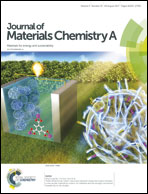Synthesis and hydrolysis of NaZn(BH4)3 and its ammoniates
Abstract
The synthesis and hydrolysis performance of NaZn(BH4)3 and its ammoniates were investigated in this paper. The successful synthesis of NaZn(BH4)3 and its ammoniates was confirmed by X-ray diffractometry and Fourier transform infrared spectroscopy measurements. The hydrolysis results show that NaZn(BH4)3 is able to generate 1740 mL g−1 hydrogen in 5 min and 1956 mL g−1 hydrogen in 30 min without concomitant release of undesirable gases such as ammonia or boranes. This rate can be too fast to be controllable in some hydrogen generation cases. In addition, it is found that NaZn(BH4)3·2NH3 generates 118 mL g−1 hydrogen in 5 min and 992 mL g−1 hydrogen in 2 h, accompanied by an emission of a small amount of ammonia. Furthermore, an enhanced hydrolysis performance can be achieved by formation of NaZn(BH4)3/NaZn(BH4)3·2NH3 composites. These composites synthesized via a planetary ball milling technique may generate hydrogen with a very reasonable and controllable speed of 717 mL g−1 hydrogen in 5 min and 1643 mL g−1 hydrogen in 2 h. The activation energies for the hydrolysis in deionized water of NaZn(BH4)3, NaZn(BH4)3·2NH3 and the NaZn(BH4)3/NaZn(BH4)3·2NH3 composite milled for 30 min were calculated to be 11.9 kJ mol−1, 56.9 kJ mol−1 and 32.5 kJ mol−1, respectively. These results demonstrate that the catalyst-free NaZn(BH4)3 and its ammoniates show better hydrolysis kinetics than other NaBH4 based materials and have the potential to be used as solid hydrogen generation materials.



 Please wait while we load your content...
Please wait while we load your content...